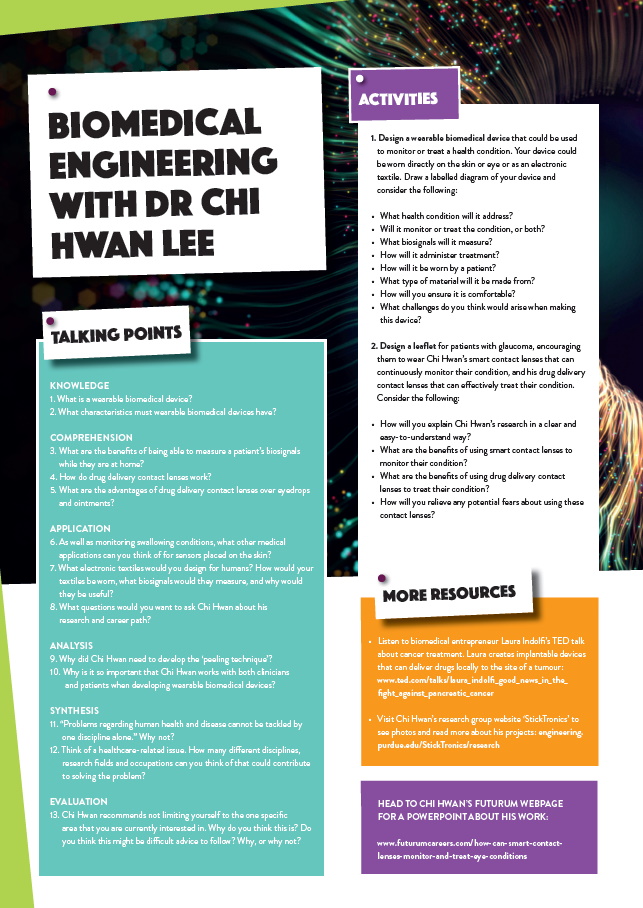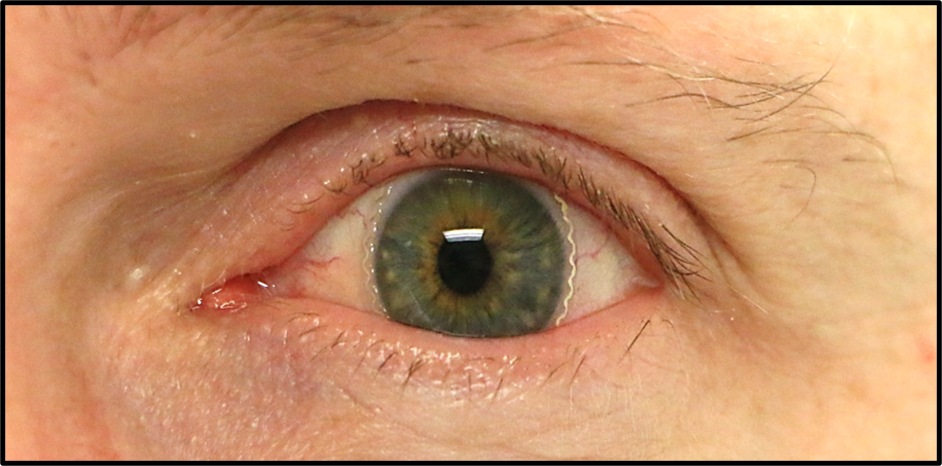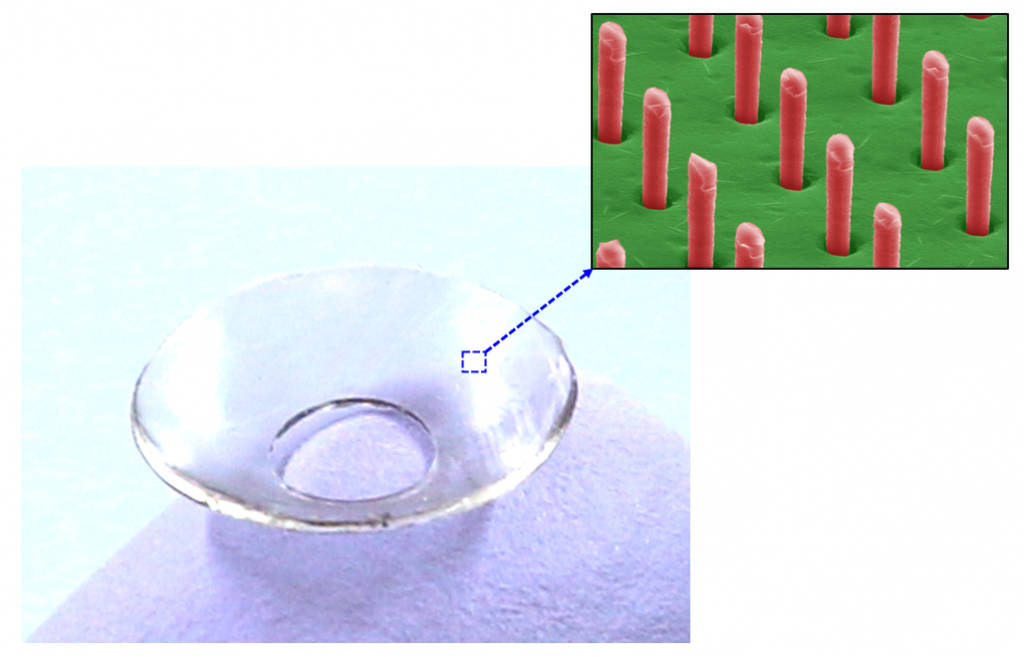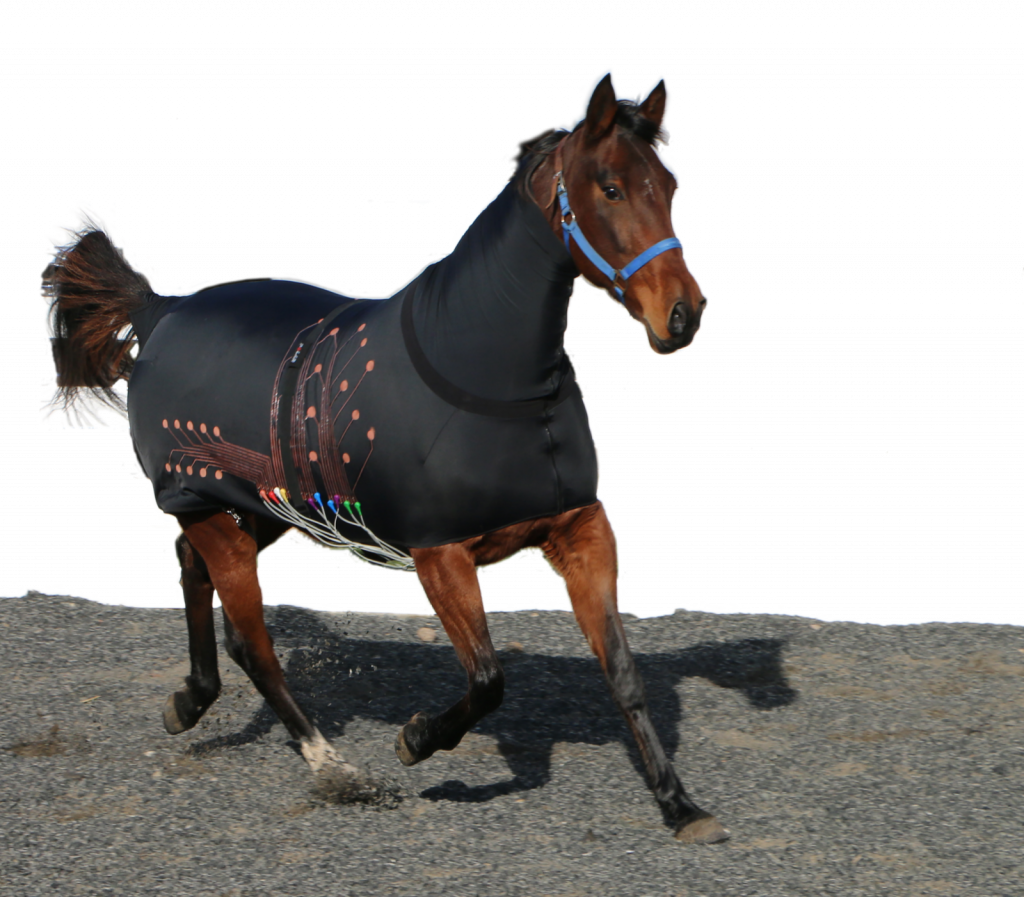How can smart contact lenses monitor and treat eye conditions?
More than 3 million people live with glaucoma in the United States, an eye disease that is the world’s second leading cause of blindness. At Purdue University, Dr Chi Hwan Lee is using his skills as a biomedical engineer to develop smart contact lenses that can both monitor the condition and deliver drugs to combat it.
TALK LIKE A BIOMEDICAL ENGINEER
BIOAVAILABILITY — the fraction of a drug that enters the body and has an active effect
BIOSIGNAL — a signal in living organisms that can be measured e.g., heart rate
CORNEA — the transparent layer forming the front of the eye
GLAUCOMA — an eye condition in which increased pressure within the eyeball can lead to an eventual loss of sight
OCULAR — an adjective describing something concerned with the eye or vision
WEARABLE BIOMEDICAL DEVICE — an electronic device that can be comfortably worn on the body while performing a specific medical function
Imagine wearing contact lenses that could not only monitor your eyes to check for diseases, but could also send reports to your doctor and administer drugs directly into your eyes to improve your condition, all while you are sat in the comfort of your own home. This futuristic-sounding type of healthcare could soon become a reality. Dr Chi Hwan Lee, associate professor of biomedical engineering and mechanical engineering at Purdue University, is developing smart contact lenses that can do just that.
Biomedical engineering lies at the heart of medical technology, where researchers collaborate with healthcare practitioners to develop new and innovative devices that can improve the lives of patients. Chi Hwan’s research group is designing wearable biomedical devices that can be attached to a patient’s eye or skin to monitor or treat specific health conditions.
WHAT CAN THESE DEVICES MONITOR?
Wearable sensors can be tailored to monitor a range of physical (e.g., pressure and strain), electrophysical (e.g., heart and muscle activities) and electrochemical (e.g., chemicals in blood or sweat) biosignals. For example, sensors attached to the skin under the chin could be used to monitor muscle activity in individuals suffering from swallowing disorders, and contact lenses could monitor ocular pressure in those suffering from glaucoma. As more than 3 million people live with glaucoma in the United States, and it is the second leading cause of blindness worldwide, finding ways to monitor the condition is essential for medical research and patient welfare.
As well as providing continuous monitoring of a patient’s condition, another major benefit of Chi Hwan’s wearable devices is their ability to record a patient’s biosignals while they are at home and then to automatically send a report to their doctor. “This means patients do not need to frequently travel to a clinic, which is particularly helpful for those living in rural areas or with limited mobility,” Chi Hwan explains.
WHAT ARE THE CHALLENGES OF CREATING WEARABLE BIOMEDICAL DEVICES?
“The human skin and eye are soft, curvilinear and sensitive to pain,” explains Chi Hwan. “Therefore, wearable biomedical devices must have mechanical softness, flexibility, stretchability and breathability, without side effects such as discomfort, pain or tissue damage.”
A major challenge for designing smart contact lenses is that the fabrication of wireless sensors typically requires high temperatures and corrosive chemicals, which is why electronic circuits are normally built on hard materials. However, these rigid materials are unsuitable for use in the human eye, so Chi Hwan and his team had to develop novel techniques for creating soft and stretchable sensors that could be placed on various commercial brands of soft contact lenses.
They developed a ‘peeling technique’, whereby the electronic components are constructed on conventional fabrication substrates that can withstand high temperatures and corrosive chemicals but can then be thinly peeled off and transferred elsewhere. This means the sensors can exist on flexible, stretchable, transparent or biodegradable substrates, including soft contact lenses.
WHAT CAN SMART CONTACT LENSES DO?
Chi Hwan’s team has developed a soft, ultrathin, wireless sensor to measure ocular pressure, which can be attached to commercial soft contact lenses. “This allows continuous 24-hour monitoring of ocular pressure for glaucoma patients, even during sleep,” he explains.
As well as monitoring eye conditions, smart contact lenses can also treat them, by injecting drugs directly into the eye. “Ocular drug delivery remains a grand challenge due to the complex structure of the eye,” says Chi Hwan.
Reference
https://doi.org/10.33424/FUTURUM303
Eyedrops and ointments that are traditionally used to administer ocular drugs have a very low bioavailability. Less than 5% of eyedrop medication reaches its target, as our eyes are designed to prevent foreign substances from entering. “This means larger or more frequent doses are required,” says Chi Hwan, “which burdens the patient and increases the risk of side effects such as blurred vision and discomfort.”
In response to this, Chi Hwan has developed tear-soluble contact lenses equipped with biodegradable nanoneedles that can inject drugs directly into the required location. “When a patient inserts the contact lens, the nanoneedles penetrate the cornea in a minimally-invasive manner and then undergo gradual degradation over the course of several months while providing sustained, painless delivery of ocular drugs,” he explains. “The contact lens itself dissolves in tear fluid within a few minutes.” These drug delivery contact lenses will be useful for treating chronic ocular diseases, such as glaucoma, as they will provide painless, long-term, sustained drug delivery to the patient’s eye.
WHAT OTHER DEVICES IS THE TEAM CREATING?
Chi Hwan and the team are also designing other wearable biomedical devices. They are integrating electronics (such as heart rate sensors) into fabric textiles, creating fabrics that can monitor health conditions while also retaining their original wearability and breathability. A key condition of these electronic textiles is that they can be worn multiple times and can survive for multiple laundry cycles.
These electronic textiles have recently been applied in a wearable biomedical device for horses. The team created a horse blanket containing multiple sensors that continuously monitor the horse’s heart rate, muscle activity and breathing rate. This allows the horse owner to monitor the horse’s health over long periods of time, whether they are galloping through a field or asleep in their stable.
WHAT NEXT?
“My next steps will be to bring the research outcomes out of university and into clinical practice so many people can benefit from using our technologies,” says Chi Hwan. He hopes that, after extensive clinical trials, his wearable biomedical devices will become commercially available, enhancing and advancing the care of patients with a wide range of health conditions.
 DR CHI HWAN LEE
DR CHI HWAN LEE
Leslie A. Geddes Associate Professor of Biomedical Engineering and Mechanical Engineering, Purdue University, West Lafayette, Indiana, USA
FIELD OF RESEARCH: Biomedical Engineering
RESEARCH PROJECT: Developing wearable biomedical devices for the skin and eye
FUNDERS: National Institutes of Health (NIH), National Science Foundation (NSF), Department of Defence (DOD), Eli Lilly and Company, Purdue University
ABOUT BIOMEDICAL ENGINEERING
Biomedical engineering is a field that spans many disciplines, combining engineering, biology, medicine and healthcare. Biomedical engineers aim to solve health problems by developing new technologies for clinical use. “As a biomedical engineer, I enjoy spending every moment solving real-world problems by emphasising the importance of team science and interdisciplinary research,” says Chi Hwan.
HOW INTERDISCIPLINARY IS THE FIELD?
“Problems regarding human health and disease cannot be tackled by one discipline alone,” says Chi Hwan. “I work with collaborators in numerous fields: biomedical, mechanical and materials engineering; speech, language and hearing science; animal science; vision science; medicine… We also actively interact with clinicians, patients and caregivers to identify all aspects of the current challenges in clinical settings. These collaborations are extremely important as their feedback helps us to create patient-centred designs.”
Collaborations within and outside academia are vital for ensuring that any technology developed by biomedical engineers will meet the needs of the end-user. “I believe that the success of future biomedical engineers, and all scientists, requires an understanding of interdisciplinary collaborations,” says Chi Hwan.
WHAT DO BIOMEDICAL ENGINEERS DESIGN?
In the past, biomedical engineers have given us pacemakers, bionic limbs, hearing aids and MRI scanners. Current topics of research include 3D printing human organs for transplants and designing nano-robots that can enter the bloodstream and release drugs directly into cancerous cells. What new inventions will biomedical engineers develop in the future as technology advances?
EXPLORE CAREERS IN BIOMEDICAL ENGINEERING
• Purdue University’s Weldon School of Biomedical Engineering (engineering.purdue.edu/BME ) runs a summer internship programme. Underrepresented students from local high schools can participate in paid opportunities to develop their interests in science, technology, engineering and mathematics (STEM).
• Many research groups in the school also offer internship programmes for high school and undergraduate students, including Chi Hwan’s lab (engineering.purdue.edu/StickTronics ). Participating in such an internship will allow you to experience the work of biomedical engineers while contributing to research projects that are tackling problems facing human health. Contact biomedical engineers at universities near you to see if they offer similar opportunities.
• Purdue University hosts STEM outreach programmes designed for young female students, including the ‘Introduce a Girl to Engineering Day’ (IGED; www.purdue.edu/wiep/FutureStudents/IGED.html) and ‘Girls in Engineering, Math, and Science’ (GEMS; gems.education.purdue.edu ) events.
• The Biomedical Engineering Society is the professional society for biomedical engineers: www.bmes.org
• Prospects provides information about the type of work you could do as a biomedical engineer: www.prospects.ac.uk/job-profiles/biomedical-engineer
PATHWAY FROM SCHOOL TO BIOMEDICAL ENGINEERING
• “Students who have a strong passion for applying the problem-solving techniques of engineering to medicine, and those who love to collaborate with others in different disciplines, will fit perfectly into pursuing a career in biomedical engineering,” says Chi Hwan.
• At school, study maths, physics, biology and chemistry.
• Some universities will offer degrees in biomedical engineering. Other related degrees that could lead to a career in the field include biomedical science, electrical or electronic engineering, mechanical or industrial engineering, or physics.
• Chi Hwan recommends taking courses in linear algebra, multivariate calculus, chemistry, statistics, dynamics, electricity, magnetism, physics and programming while at university.
HOW DID CHI HWAN BECOME A BIOMEDICAL ENGINEER?
I grew up in Incheon, one of the largest industrial complexes in South Korea, where my interest in manufacturing began from watching factories. This circumstance in my childhood naturally drove me towards the manufacturing industry, and I imagined myself working as a manufacturing consultant. This was the primary reason that I chose to study both industrial engineering and mechanical engineering for my dual degrees at Ajou University in South Korea and Illinois Tech in the US.
To strengthen my expertise in the manufacturing field, I then pursued a master’s and PhD in mechanical engineering at Stanford University, USA. I focused on the development of a ‘solar sticker’ through the innovation of nanomanufacturing technology.
At that point, I never imagined that I would go into the biomedical field. However, I had an interview at Purdue University where I had the chance to meet several researchers from different disciplines, including biomedical, mechanical, electrical and materials engineering.
Talking with them, I realised my research on manufacturing solar stickers could be expanded to manufacturing sensor stickers, which could be particularly useful for many biomedical applications.
I found the highly interdisciplinary, collaborative environment in Purdue very attractive. It enabled me to naturally switch a gear in my profession and begin focusing on wearable biomedical devices. I now have a very interdisciplinary background to my career, with dual degrees in industrial engineering and mechanical engineering, post-doctoral training in materials engineering and research in biomedical engineering.
This interdisciplinary background has allowed me to foster a lot of internal and external collaborations with world-leading scientists and engineers, enabling us to tackle the complicated real-world problems associated with human health and diseases.
My ambitions lie in translating some of these research initiatives into tangible forms which will eventually benefit millions of users in need across the world.
CHI HWAN’S TOP TIPS
01 Do not limit yourself to the one specific area that you are currently interested in.
02 Do not be afraid to try something new and do not be afraid to fail.
Do you have a question for Chi Hwan?
Write it in the comments box below and Chi Hwan will get back to you. (Remember, researchers are very busy people, so you may have to wait a few days.)








How can I participate in this program, I have Gloucoma now for 14 years.
Hello Dr Hwan, any projects to help with AMD in the near future? Or, could this or not be possible with these type of eye lenses?
Many thanks.
Thank you for the comment. The smart ‘soft’ contact lenses can be potentailly tailored for other ocular diseases including AMD, which presents our current efforts. Our goal is to enable our platform technology to be applicable to managing a range of ocular diseases.
I am sorry to hear that you are suffering from glaucoma. We have completed an initial set of preclinical studies and are now moving forward to a larger set of clinical studies which would be ready sooner than later. I hope our technology would be benefitial to you and many other patients in need.
Dr Hwan, we are working in 1000s of rural villages where eyecare / glaucoma is not easily accessible. Would be keen to understand if the smart soft contact lens is available for us to pilot. Would be great for the people if we can make it work. Keen to hear from you. thank you